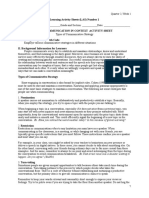5 Handout
Uploaded by
Aira Garcia5 Handout
Uploaded by
Aira GarciaORAL COMMUNICATION SENIOR HIGH SCHOOL
IN CONTEXT
SPEECH STYLE
The context dictates and affects the way people communicate, which results
in various speech styles.
According to Martin Joos (1976), a linguist and German professor, speech
style refers to the form of language that the speaker utilized which is characterized
by the level of formality. They are patterns of speaking by distinctive pronunciation,
vocabulary, intent, participants and grammatical structures. According to him, there
are five speech styles.
Types of Speech Style:
1. Intimate Style
This style is private, which occurs between or among close family members
or individuals. It is described by an economy of words, with a high chance of
nonverbal communication. Like casual, there is also a free and easy participation of
both speaker and listener. The language used in this style may not be shared in
public.
Example: conversation between couple
2. Casual Style
It is also known as informal style. It is usually used between, friends, or even
insiders who have things to share. In this type, there is a free and easy participation
of both speaker and listener. This style is also common among peers and friends.
Jargon, slang or the vernacular language are used.
Example: conversation between classmates
3. Consultative Style
This style is the standard one. It is also the third level of language. It is
basically unplanned speech since the speaker uses the participation and feedback of
the listener. The speaker will supply background information, while again, the listener
participates continuously. Professional or mutually acceptable language is a must in
this style. Examples of situations are communication between teachers and students,
employers and employees, doctor and patient, judge and lawyer, or President and
his/ her constituents.
4. Formal Style
This style is used in formal settings and uses formal words and expressions
and is mostly seen in writing rather than speaking. It also disallows the use of
ellipsis, contractions, and qualifying modal adverbials. Unlike the consultative style,
this is one-way.
ORAL COMMUNICATION IN CONTEXT HANDOUT NO. 5
ORAL COMMUNICATION SENIOR HIGH SCHOOL
IN CONTEXT
Examples: sermons by priests and ministers, State of the Nation Address of the
President etc.
5. Frozen style
It is also known as fixed speech. It is the highest form of communicative
style which is often used in respectful situations or formal ceremonies like
Shakespearean plays, weddings, funerals, Preamble to the Constitution, Lord’s
Prayer, and Allegiance to country or flag. It uses the complex grammatical sentence
structure and vocabulary that are only known by experts in that field. This style is
“frozen” in time and remains unchanged.
TYPES OF COMMUNICATIVE STRATEGY
Since engaging in conversation is also bound by implicit rules, Cohen (1990) states
that strategies must be used to start and maintain a conversation. Knowing and applying
grammar appropriately is one of the most basic strategies to maintain a conversation.
The following are some strategies that people use when communicating:
1. Nomination
A speaker carries out nomination to collaboratively and productively establish
a topic. Basically, when you employ this strategy, you try to open a topic with the
people you are talking to. When beginning a topic in a conversation, especially if
it does not arise from a previous topic, you may start off with news inquiries and
news announcements as they promise extended talk. Most importantly, keep the
conversational environment open for opinions until the prior topic shuts down
easily and initiates a smooth end. This could efficiently signal the beginning of a
new topic in the conversation.
2. Restriction
Restriction in communication refers to any limitation you may have as a
speaker. When communicating in the classroom, in a meeting, or while hanging
out with your friends, you are typically given specific instructions that you must
follow. These instructions confine you as a speaker and limit what you can say.
For example, in your class, you might be asked by your teacher to brainstorm
on peer pressure or deliver a speech on digital natives. In these cases, you
cannot decide to talk about something else. On the other hand, conversing with
your friends during ordinary days can be far more casual than these examples.
Just the same, remember to always be on point and avoid sideswiping from the
topic during the conversation to avoid communication breakdown.
3. Turn taking
Sometimes people are given unequal opportunities to talk because others
take much time during the conversation. Turn-taking pertains to the process by
which people decide who takes the conversational floor. There is a code of
behavior behind establishing and sustaining a productive conversation, but the
primary idea is to give all communicators a chance to speak.
Remember to keep your words relevant and reasonably short enough to
express your views or feelings. Try to be polite even if you are trying to take the
floor from another speaker. Do not hog the conversation and talk incessantly
without letting the other party air out their own ideas. To acknowledge others, you
may employ visual signals like a nod, a look, or a step back, and you could
accompany these signals with spoken cues such as “What do you think?” or “You
wanted to say something?”
ORAL COMMUNICATION IN CONTEXT HANDOUT NO. 5
ORAL COMMUNICATION SENIOR HIGH SCHOOL
IN CONTEXT
4. Topic Control
Topic control covers how procedural formality or informality affects the
development of topic in conversations. For example, in meetings, you may only
have a turn to speak after the chairperson directs you to do so. Contrast this with
a casual conversation with friends over lunch or coffee where you may take the
conversational floor anytime.
Remember that regardless of the formality of the context, topic control is
achieved cooperatively. This only means that when a topic is initiated, it should
be collectively developed by avoiding unnecessary interruptions and topic shifts.
You can make yourself actively involved in the conversation without overly
dominating it by using minimal responses like “Yes,” “Okay,” “Go on”; asking tag
questions to clarify information briefly like “You are excited, aren’t you?”, “It was
unexpected, wasn’t it?”; and even by laughing!
5. Topic Shifting
Topic shifting, as the name suggests, involves moving from one topic to
another. In other words, it is where one part of a conversation ends and where
another begins.
When shifting from one topic to another, you have to be very intuitive. Make
sure that the previous topic was nurtured enough to generate adequate views.
You may also use effective conversational transitions to indicate a shift like “By
the way,” “In addition to what you said,” “Which reminds me of,” and the like.
6. Repair
Repair refers to how speakers address the problems in speaking, listening,
and comprehending that they may encounter in a conversation. For example, if
everybody in the conversation seems to talk at the same time, give way and
appreciate other’s initiative to set the conversation back to its topic.
Repair is the self-righting mechanism in any social interaction (Schegloff et al,
1977). If there is a problem in understanding the conversation, speakers will
always try to address and correct it. Although this is the case, always seek to
initiate the repair.
7. Termination
Termination refers to the conversation participants’ close-initiating
expressions that end a topic in a conversation. Most of the time, the topic
initiator takes responsibility to signal the end of the discussion as well.
Although not all topics may have clear ends, try to signal the end of the topic
through concluding cues. You can do this by sharing what you learned from the
conversation. Aside from this, soliciting agreement from the other participants
usually completes the discussion of the topic meaningfully.
TYPES OF SPEECH
A. According to Purpose
There are four basic types of speeches according to purpose: to inform, to
instruct, to persuade, and to entertain. You may have one specific purpose or a
combination of any of these objectives when giving your presentation. For example,
you may try to inform in an entertaining style or inform as you entertain your
audience. Another speaker, say an advertiser or a politician, might inform the
audience and try to persuade them to act on the information.
ORAL COMMUNICATION IN CONTEXT HANDOUT NO. 5
ORAL COMMUNICATION SENIOR HIGH SCHOOL
IN CONTEXT
1. Informative. This speech serves to provide interesting and useful information to
your audience like your teacher talking about earthquakes or a fellow student
presenting his/her research. In a paper/research presentations or academic,
speakers aim to give significant information to the audience.
Example: lecture of a teacher
2. Demonstrative. This has many similarities with an informative speech but it also
teaches you to do or perform something. A cooking demonstration is a good
example of this kind of speech which instructs the audience on how to do
something step by step. Have you gone to big malls where they demonstrate
how
to arrange flowers or to decorate cakes and cookie? Notice that the speakers or
demonstrators deliver their respective speech while demonstrating or performing
the process.
3. Persuasive. A persuasive speech aims to persuade or convince people to
change
the way they think or do something, or to start doing something that they are not
currently doing. Most political speeches aim at targeting the belief system of the
listeners. They can make the audience laugh, like, love, want, or desire a
specific
change or make them reject or hate a policy, program, service, or even
institution
and other people, talks on becoming an organ donor or improving your health
through better eating are simple examples.
.
4. Entertaining. The speech during a program intermission or after dinner is a
typical
example of an entertaining speech. The speaker provides pleasure and
enjoyment that make the audience laugh or identify with anecdotal information.
The toastmaster speech is known to have such characteristics. Have you tied
speaking in your friend’s birthday party? The invited speaker is usually a person
full of pep. She/he can entertain the guests and make the party atmosphere
pleasant.
5. Inspirational. It aims to motivate or inspire an audience, to help them be
positive
and optimistic about things.
6. Argumentative. It aims to convert the audience to agree on the speaker’s side
or
point.
Argumentative Vs Persuasive Speech
A persuasive speech does not only intend to change the beliefs of others
but also their attitude and behavior.
An argumentative speech only convinces people to accept a fact or point of
view.
A persuasive speech makes people apply what they have learned or do the
action immediately or in the future.
B. According to Delivery
ORAL COMMUNICATION IN CONTEXT HANDOUT NO. 5
ORAL COMMUNICATION SENIOR HIGH SCHOOL
IN CONTEXT
Another way of classifying speeches is the manner by which the speech will be
presented to the audience. This classification is by delivery method. There a few ways
in which this is done.
1. Manuscript. It is the word-for-word iteration of a written message using visual
aids. Before delivering this speech, the speaker prepares the manuscript that
he/she has to present. This requires the speaker to read every word in it. This
type of speech happens when the speaker cannot afford to commit any mistake or
when the script has to be read exactly as it was written. These situation may
require reading from a manuscript. However, it can be boring. You still need to
connect with the audience through eye contact. You also need to be animated in
reading the speech by varying your intonation, rate and rhythm, and by pausing
once in a while to look at the listeners. Without animation or movement on stage,
the audience may become disinterested.
Example: News anchor with a teleprompter
To succeed, you need to:
a. Focus on key phrases and highlight key words on your manuscript.
b. Practice your speech repeatedly.
c. Glance at the highlighted words to remember which idea comes next.
d.Thoroughly familiarize yourself with the substance of your speech and the
sequence of your main points.
e. Maintain a conversational tone.
f. Periodically look at your audience.
2. Memorized- It is the rote recitation of a written message that the speaker has
committed to memory. This usually sounds mechanical and is seldom used or
recommended.
Example: actor’s dialogue
If you choose to memorize:
a. Keep it short.
b. Add expression in your voice.
3. Extemporaneous. This speech allows the speaker to prepare his/her thoughts
and mode of delivery. Note cards or short outlines written on a small sheet of
paper help significantly in making the speech delivery organized. These note
cards or prompts tell you where to go next but you see your own words
throughout the speech. This makes this type of delivery different from the
impromptu speech, which does not allow the speaker to prepare ahead of time. In
an extemporaneous speech, you are given enough time to prepare for it.
Example: a campaign speech before a voting public
To succeed, you need to:
a. Do research on the topic.
b. Have enough practice delivering the speech to gain self-confidence.
ORAL COMMUNICATION IN CONTEXT HANDOUT NO. 5
ORAL COMMUNICATION SENIOR HIGH SCHOOL
IN CONTEXT
4. Impromptu. This type of speech is delivered “on the spur of the moment” and this
depends solely on your ability to speak in an instant. Many time, you have done
this in class when your teachers ask you to explain or justify your answers without
asking you to look at your notes. You also see this in beauty pageants where the
candidate is asked by a judge o by the master of ceremony in an instant. While it
is not easy to do this; anybody can prepare for such impromptu speeches.
Example: a doctor’s response to the question of a patient
To be successful, you need to:
a. Consider the question and statement to which you are about to reply or react.
b. Speak briefly but be sure to speak about the significant point/s.
c. Compose yourself as you organize your thoughts logically.
d. Be mindful of what you say but not overly self-conscious.
e. Breathe properly.
PRINCIPLES OF SPEECH DELIVERY
Effective Speech Delivery completes the hard work of preparing it. It compromises
wording and delivery for the speaker to sound confident and intelligible when giving the
speech. Remember that it is important that the speaker be understood and the goal of the
speech be achieved. Speech should be conversational, in that the audience should feel you
are talking with them, not at them.
Things to consider:
1. VOICE. Always remember to be understandable and vocally expressive. Do not talk too
softly nor too quickly. Be aware of your articulation and pronunciation problems and
address them properly.
TIP: Consider the context of your speech and adjust your voice. It could add meaning to
your words.
First: Stress Important Words, Subordinate Unimportant Ones
In conversation, we hit one syllable in a word, and hit it hard, and hurry over the others;
e.g., afFLICtion, atTRACtiveness, enVIRonment.
We do almost the same thing with a sentence. We make one or two important words
tower over the others.
Here is an example. Read the following quotation, striking the words in a big type hard.
Run over the others quickly. What is the effect?
I have SUCCEEDED in whatever I have undertaken, because I have WILLED it. I have
NEVER HESITATED which has given me an ADVANTAGE over the rest of mankind. —
Napoleon.
Second: Change Your Pitch
When you find yourself talking in a monotonous pitch—and usually it will be a high one—
just pause for a second and say to yourself: “I am speaking like a robot. Talk to
these people. Be human. Be natural.”
ORAL COMMUNICATION IN CONTEXT HANDOUT NO. 5
ORAL COMMUNICATION SENIOR HIGH SCHOOL
IN CONTEXT
In the following quotations, try saying the italicized words in a much lower pitch than you
use for the rest of the sentence. What is the effect?
I have but one merit, that of never despairing. —Marshal Foch.
The great aim of education is not knowledge, but action. —Herbert Spencer.
I have lived eighty-six years. I have watched men climb up to success, hundreds of
them, and of all the elements that are important for success, the most important is
faith. —Cardinal Gibbons.
Third: Vary Your Rate of Speaking
A short time before his death, Cardinal Gibbons said: “I have lived eighty-six years. I
have watched men climb up to success, hundreds of them, and of all the elements that
are important for the success, the most important is faith. No great thing comes to any
man unless he has courage.”
Try this: say “thirty million pesos” quickly and with an air of triviality so that it sounds like
a very small sum. Now, say “thirty thousand pesos”; say it slowly; say it feelingly; say it
as you were tremendously impressed with the hugeness of the amount. Haven’t you now
made the thirty thousand sound larger than thirty million?
Fourth: Pause Before and After Important Ideas
Read the selection aloud without pausing; then read it again, making the pauses that
indicated. What is the effect of the pauses?
“Selling goods is a battle” (pause and let the idea of battle soak in) “and only fighters
can win in it.” (Pause and let that point soak in.) “We may not like these conditions, but
we didn’t have the making of them and we can’t alter them.” (Pause.)“ Take your
courage with you as you enter the selling game.” (Pause.) “If you don’t,” (pause and
lengthen out suspense for a second) “you’ll strike out every time you come to bat, and
score nothing higher than a string of goose eggs.” (Pause.) “No man ever made a three-
base hit who was afraid of the pitcher” (pause and let it soak in) —“remember that.”
(Pause and let it soak in some more.) “The fellow who knocks the cover off the ball or
lifts it over the fence for a home run is always the chap who steps up to the plate”
(pause and increase the suspense as to up to the plate” (pause and increase the
suspense as to what you are going to say about this extraordinary player) “with grim
determination in his heart.”
2. BODY. We say that “actions speak louder than words” and your gestures mean a lot.
Good vocal register is complimented with good eye contact, facial expressions, and
gestures. Always look at your audience eye-to-eye to ensure rapport. Make the
appropriate facial expressions with your statements to highlight meaning and avoid
confusion.
TIP: Do not overly react and move a lot. Be sure that your body movements and
gestures correspond to what you are saying.
3. APPEARANCE. You could give an impression of an effective speaker if they see that
you are confident with your appearance. Dress up properly; consider the occasion and
the type of audience that you have.
TIP: First impression lasts. Your attire is an important as your speech so make sure you
are dressed properly, but do not dress up exaggeratedly.
PRINCIPLES OF SPEECH WRITING
ORAL COMMUNICATION IN CONTEXT HANDOUT NO. 5
ORAL COMMUNICATION SENIOR HIGH SCHOOL
IN CONTEXT
Writing a speech is far different from writing an effective speech. It does not just
involve sharing what you know about any topic and inviting the audience to believe your
point. An effective speech is one that offers complete information about the topic,
keeps the audience motivated to listen, and most importantly, receives good
feedback from the audience. In order to achieve these goals, one should be able to have a
good topic, prepare a comprehensive outline of the speech and consider the characteristics
of an effective speech, which are also in congruence with the steps to follow in writing a
good speech.
1. Speech should be audience-centered.
You can deliver audience-centered speeches if you keep your focus on your audience
when preparing your speech—tailoring the content to their interests, desires, and needs,
and simply means that everything starts with the selection of good topic and considering
the type of audience that you have.
2. Speech should be well-planned and well-outlined.
Aside from having a good topic, a speech should follow a comprehensive outline of
information to invite the audience and keep them motivated to listen. It should offer a
complete menu – appetizers to sizzle the eyes and ears to listen, main meals to satisfy
their hunger for information, and desserts to end their cravings for more.
There are four steps to follow in writing a speech, namely:
a. Choosing the Topic
First and foremost, you have to select a good topic. How? You have to consider your
goal. Do you wish to inform, instruct, persuade, or simply entertain during a special
occasion? Then, choose a particular topic to work on, something that interests you
and that you already know something about. And for sure, you will be motivated to
work on it because it suits your interests.
Tip: Brainstorming for Ideas. Try to write general topics and narrow it down to more
specific topics. If you started with sports, enumerate some sports of your interests
and identify some common topics which are in season. Outlining and having your
thesis statement could be a great help.
b. Analyzing the Audience
In relation to the topic is the audience. You have to adapt your speech to the
audience’s interests, needs and expectations as well. Consider their level of
education, gender, income, occupation, race, ethnicity, religion, geographic
uniqueness, and language. From this information, you could estimate how your
audience will receive and react to your ideas, and therefore make the necessary
adjustments. Some topics may also be added or deleted depending on the type of
audience that you have, although you may also consider a heterogeneous group and
be flexible.
Tip: Be careful with your choice of words. This is the most important thing to bear in
mind because it greatly affects how people see things and could influence their way
of thinking.
c. Sourcing the Information
ORAL COMMUNICATION IN CONTEXT HANDOUT NO. 5
ORAL COMMUNICATION SENIOR HIGH SCHOOL
IN CONTEXT
The next most important thing to do is gather information about the topic. Select
relevant materials and consider breadth, depth, relevance to the topic and for the
audience, and novelty (humorous, exciting, or unique/interesting experiences and
stories) to illustrate your points, as well as the quality of the sources of your
information. You may also share your experiences which you think are relevant to
the topic.
TIP: Be sure that you present honest and reliable information. You will be sharing
this to the audience and your credibility lies on it. It could surely reflect what kind of
speaker you are and this could affect the whole communication process.
d. Outlining and Organizing the Information
Start with the key points that you want your audience to remember. Highlight the
most important part of your speech by giving a thesis statement and provide
supporting details. Outline the speech following a specific pattern depending on the
type of speech. If it is a narrative speech, try using a problem-solution pattern. This
way, the audience can grasp the essence of the speech.
TIP: Identify the main points of your arguments and provide details. Present your
work in an organized manner to prevent doubt and uncertainty. Be sure to convince
the audience with your stand.
+
REFERENCES
Antonino, M. et. al. (2016). Oral Communication in Context. Malabon City: Mutya Publishing
House, Inc.
Carnegie, D. (1956). How to Develop Self-Confidence and Influence People by Public
Speaking. New York: Pocket Books Nonfiction.
Delos Reyes, D. (2012). Speak With Butterflies. Quezon City: RAdelosReyes Management
Consultant
Gasulas, A. et. al. 2016. Integrated English for Effective Communication. Quezon City:
Phoenix Publishing House, Inc.
ORAL COMMUNICATION IN CONTEXT HANDOUT NO. 5
You might also like
- Herb Dewey - Mindblowing Psychic Readings OCRd82% (11)Herb Dewey - Mindblowing Psychic Readings OCRd72 pages
- Types of Speech Style and Communicative Strategy100% (2)Types of Speech Style and Communicative Strategy5 pages
- Oral Communication in Context: Quarter 2 - Module 3No ratings yetOral Communication in Context: Quarter 2 - Module 312 pages
- Types of Communicative Strategy: Lesson 1No ratings yetTypes of Communicative Strategy: Lesson 125 pages
- Module 6 Types of Communicative Strategies 1No ratings yetModule 6 Types of Communicative Strategies 17 pages
- Oral Communication in Context: Self-Learning ModulesNo ratings yetOral Communication in Context: Self-Learning Modules12 pages
- 2ND Quarter Module Oral Communication 11No ratings yet2ND Quarter Module Oral Communication 1165 pages
- LECTURE-NOTES-LESSON-10-11-COMMUNICATIVE-STRATEGIES-AND-SPEECH-ACTSNo ratings yetLECTURE-NOTES-LESSON-10-11-COMMUNICATIVE-STRATEGIES-AND-SPEECH-ACTS2 pages
- Q1 Module 7 - Topic7 - Communicative Strategy100% (1)Q1 Module 7 - Topic7 - Communicative Strategy7 pages
- Types of Communicative Strategies: 1. NominationNo ratings yetTypes of Communicative Strategies: 1. Nomination3 pages
- q1 Module 7 - Topic7 - Communicative StrategyNo ratings yetq1 Module 7 - Topic7 - Communicative Strategy5 pages
- Strategies in Various Speech Situations: Intrapersonal CommunicationNo ratings yetStrategies in Various Speech Situations: Intrapersonal Communication5 pages
- Reviewer On Oral Communication For 2nd Quarter100% (1)Reviewer On Oral Communication For 2nd Quarter10 pages
- ORAL-COMMUNICATION-IN-CONTEXT-SECOND-QUARTER-REVIEWER (3)No ratings yetORAL-COMMUNICATION-IN-CONTEXT-SECOND-QUARTER-REVIEWER (3)11 pages
- Oral-Communication-in-Context-Pointers-to-ReviewNo ratings yetOral-Communication-in-Context-Pointers-to-Review3 pages
- Learners Activity Sheet Oral CommunicationNo ratings yetLearners Activity Sheet Oral Communication5 pages
- Communicative Strategies Are Techniques On How To Deal With Difficulties Encountered When CommunicatingNo ratings yetCommunicative Strategies Are Techniques On How To Deal With Difficulties Encountered When Communicating5 pages
- Second Quarter Oral Com Topics For StudentsNo ratings yetSecond Quarter Oral Com Topics For Students11 pages
- The Power of Small Talk: Unlocking the Secrets of Casual ConversationFrom EverandThe Power of Small Talk: Unlocking the Secrets of Casual ConversationNo ratings yet
- Copyreading and Headline Writing - Samantha F. Batalla100% (1)Copyreading and Headline Writing - Samantha F. Batalla56 pages
- 4G Single Radio Access Network (SRAN) : Course Code: TRC-830No ratings yet4G Single Radio Access Network (SRAN) : Course Code: TRC-8303 pages
- 9MA0 01 9MA0 02 A Level Pure Mathematics Practice Set 13No ratings yet9MA0 01 9MA0 02 A Level Pure Mathematics Practice Set 135 pages
- Update Relationship in Primavera P6 by Excel Help and ManuallyNo ratings yetUpdate Relationship in Primavera P6 by Excel Help and Manually5 pages
- Systems Analysis and Design 11th Edition Tilley Test Bank PDF Download Full Book with All Chapters100% (9)Systems Analysis and Design 11th Edition Tilley Test Bank PDF Download Full Book with All Chapters40 pages
- Worksheet 26 Pronouns and Their AntecedentsNo ratings yetWorksheet 26 Pronouns and Their Antecedents2 pages
- Review of "An Economic Analysis of A Drug-Selling Gang's Finances" by Steven D. Levitt and Sudhir Alladi VenkateshNo ratings yetReview of "An Economic Analysis of A Drug-Selling Gang's Finances" by Steven D. Levitt and Sudhir Alladi Venkatesh2 pages
- History of Philadelphia International AirportNo ratings yetHistory of Philadelphia International Airport3 pages
- Oral Communication in Context: Quarter 2 - Module 3Oral Communication in Context: Quarter 2 - Module 3
- Oral Communication in Context: Self-Learning ModulesOral Communication in Context: Self-Learning Modules
- LECTURE-NOTES-LESSON-10-11-COMMUNICATIVE-STRATEGIES-AND-SPEECH-ACTSLECTURE-NOTES-LESSON-10-11-COMMUNICATIVE-STRATEGIES-AND-SPEECH-ACTS
- Strategies in Various Speech Situations: Intrapersonal CommunicationStrategies in Various Speech Situations: Intrapersonal Communication
- ORAL-COMMUNICATION-IN-CONTEXT-SECOND-QUARTER-REVIEWER (3)ORAL-COMMUNICATION-IN-CONTEXT-SECOND-QUARTER-REVIEWER (3)
- Communicative Strategies Are Techniques On How To Deal With Difficulties Encountered When CommunicatingCommunicative Strategies Are Techniques On How To Deal With Difficulties Encountered When Communicating
- The Power of Small Talk: Unlocking the Secrets of Casual ConversationFrom EverandThe Power of Small Talk: Unlocking the Secrets of Casual Conversation
- Copyreading and Headline Writing - Samantha F. BatallaCopyreading and Headline Writing - Samantha F. Batalla
- 4G Single Radio Access Network (SRAN) : Course Code: TRC-8304G Single Radio Access Network (SRAN) : Course Code: TRC-830
- 9MA0 01 9MA0 02 A Level Pure Mathematics Practice Set 139MA0 01 9MA0 02 A Level Pure Mathematics Practice Set 13
- Update Relationship in Primavera P6 by Excel Help and ManuallyUpdate Relationship in Primavera P6 by Excel Help and Manually
- Systems Analysis and Design 11th Edition Tilley Test Bank PDF Download Full Book with All ChaptersSystems Analysis and Design 11th Edition Tilley Test Bank PDF Download Full Book with All Chapters
- Review of "An Economic Analysis of A Drug-Selling Gang's Finances" by Steven D. Levitt and Sudhir Alladi VenkateshReview of "An Economic Analysis of A Drug-Selling Gang's Finances" by Steven D. Levitt and Sudhir Alladi Venkatesh

























































































